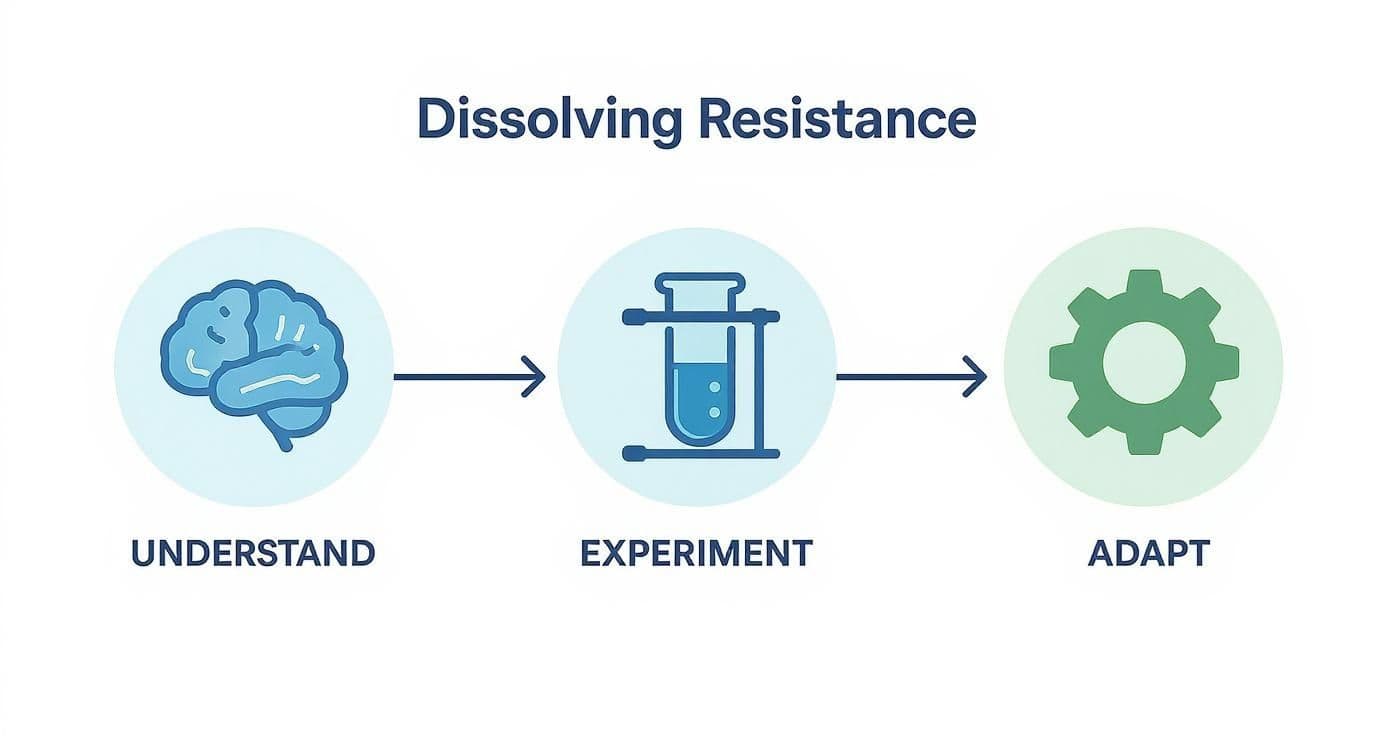Feeling stuck? Learn proven, actionable strategies for overcoming resistance to change by understanding its roots and aligning with your unique life purpose.
November 22, 2025 (1d ago)
Overcoming Resistance to Change A Practical Guide
Feeling stuck? Learn proven, actionable strategies for overcoming resistance to change by understanding its roots and aligning with your unique life purpose.
← Back to blog
Overcome Resistance to Change: Practical Guide
Feeling stuck? Learn proven, actionable strategies for overcoming resistance to change by understanding its roots and aligning with your unique life purpose.
Introduction
Feeling stuck is completely normal. Instead of fighting that friction, get curious about it. When you treat resistance as a guide instead of an obstacle, it can reveal what you truly need to grow. This guide shows simple, evidence-informed steps to understand resistance, test change without overwhelm, and align action with your deeper purpose.
Why We Naturally Resist Change

Staring at a new job, a healthier routine, or a shift in a relationship can feel unexpectedly daunting. Our brains prefer predictability because predictability supports safety. Change breaks that pattern and brings uncertainty, which triggers unease. A better approach than forcing your way through is to lean into small, manageable adjustments that build momentum.
The Psychology Behind Resistance
Most hesitation comes from a few common psychological triggers. Name them, and you can work with them rather than against them. Think of resistance as having three common “faces.” Each feels different, but all come from a need to feel safe and in control.
Three Common Faces of Resistance
| Type of Resistance | What It Feels Like | A First Gentle Step |
|---|---|---|
| Fear of the Unknown | “What if it all goes wrong?” Thoughts jump to worst-case scenarios and ambiguity feels overwhelming. | Write down one potential positive outcome of the change and sit with that possibility for a few minutes. |
| Loss of Control | “This is happening to me.” You feel like a passenger, not the driver. | Identify one tiny part of the situation you can control, such as your morning routine or how you organize your workspace. |
| Echoes of the Past | “Here we go again.” A past negative experience makes you skeptical. | Acknowledge the past pain, then ask: “What is one key thing that is different about this situation right now?” |
Seeing resistance this way demystifies it. It’s not an unbeatable monster; it’s a predictable pattern based on human fears.
The goal isn’t to eliminate resistance but to understand its message. Resistance is data pointing you toward what you value, what you fear, and what you need to feel secure.
Once you identify your personal style of resistance—are you a procrastinator, a chronic doubter, or a creature of comfort?—you begin to see the pattern. Pinpointing the what and why is the single most important step. From there, you’re navigating instead of fighting.
Uncovering the True Source of Your Resistance

Before you can overcome resistance, stop fighting it. Treat the feeling like a messenger delivering an urgent memo. Your job is to get quiet enough to hear it.
Resistance is rarely about just one thing; it’s a web of thoughts, habits, and sometimes deeper impulses. By asking better questions, you can untangle what’s really holding you back.
The Psychological and Emotional Layers
Often, the loudest resistance is psychological—stories we’ve told ourselves for years about what we can and can’t do. These limiting beliefs act like invisible tripwires. Noticing them is a huge first step. For a deeper dive, see the guide on overcoming limiting beliefs at https://lifepurposeapp.com/blog/how-to-overcome-limiting-beliefs.
Try these journal prompts to start untangling your inner narrative:
- What is the absolute worst thing I imagine happening if I make this change? Follow that fear all the way down the rabbit hole.
- What comfortable routine am I secretly afraid of losing? Sometimes we’re not afraid of the unknown so much as losing the known.
- When have I felt this same resistance before? Look for patterns; the situations may differ, but the feeling will be familiar.
The Spiritual Dimension of Resistance
Sometimes resistance isn’t just in your head. It can signal a deeper misalignment with your life purpose or the timing of your journey. Dan Millman’s book, The Life You Were Born to Live, and the Life Purpose App offer a framework for understanding spiritual patterns that influence resistance.
Resistance can be a compass warning you that a change may not honor your spiritual blueprint. For someone whose path centers on creative expression, a soul-crushing corporate role will create intense friction. That resistance isn’t a flaw; it’s a red flag of misalignment.
Ask yourself:
- On a soul level, does this change feel expansive or restrictive?
- If I ignored outside expectations, would this still feel right?
By viewing resistance through psychological, habitual, and spiritual lenses, you stop being the victim and become a detective who decodes its message.
Practical Tools for Dissolving Resistance
Understanding why you resist is only the start. Now move from understanding to doing. This isn’t about forcing giant leaps; real change happens through small, deliberate steps. Build a toolkit of simple practices that make change feel like exploration rather than threat.
Start with Mini-Experiments
Mini-experiments are tiny, low-stakes actions that let you test the waters without overwhelm. They’re bite-sized versions of the change you’re considering, small enough that your brain’s alarm system doesn’t go off.
Examples:
- Considering a career change? Don’t quit. Spend 15 minutes this week researching one company you admire or send a single LinkedIn connection request.
- Want a healthier routine? Add one extra glass of water to your day or take a 10-minute walk after dinner.
- Avoiding a creative project? Open a blank document and write a single sentence.
Collecting small wins provides real-world proof that change isn’t as scary as imagined. This rewires your brain toward action.
Cultivate Daily Rituals for Adaptability
Mini-experiments get you moving; daily rituals reshape your mindset. These are small, consistent practices that build momentum over time.
A five-minute mindfulness practice helps you observe resistant thoughts without getting swept away, creating a pause between feeling and reaction. For a quick starter guide, see https://lifepurposeapp.com/blog/how-to-practice-mindfulness.
A “change gratitude” journal—writing one small positive outcome from any change each evening—trains your brain to associate change with benefits rather than just fear.
Resistance is normal, especially where routines provide stability. The key is not to ignore it, but to navigate it with clear communication and empathy.
Organizational change often magnifies personal resistance. About 37% of employees actively resist change, with common causes including lack of trust in leadership, fear of the unknown, and insufficient information1. At scale, this resistance helps explain why so many change initiatives fail; a well-cited estimate finds around 70% of organizational change initiatives do not achieve their goals2.
Aligning Change with Your Authentic Life Path
What if resistance isn’t a flaw but a guide? Sometimes the friction you feel signals that a change doesn’t fit who you are. Understanding your innate design can be a game-changer.
Dan Millman’s framework and the Life Purpose App present a practical way to decode your strengths, challenges, and life themes. Your life number, calculated from your birthday, acts like a blueprint that explains why you excel in some areas and repeatedly hit walls in others. Knowing this context can dissolve friction quickly.
This is a three-stage process: understand your core nature, experiment with aligned changes, and adapt based on feedback.

Is the Timing Right for This Change?
Beyond your core path, Millman’s system maps nine-year cycles that influence life themes. Some years support bold beginnings; others favor consolidation and reflection. Forcing a major project during an introspective year can feel like swimming against a current. Understanding cycles helps you work with your natural rhythm rather than against it.
Aligning efforts with your nature and timing is one of the most effective ways to overcome resistance. Choose the right boat and sail with the current.
This principle applies broadly. Organizational failure often comes when change feels forced and misaligned with the people it affects. Tools that increase self-knowledge help reduce guesswork and improve alignment.
How to Handle Common Setbacks and Plateaus
The path to meaningful change is rarely straight. You will hit stuck moments. Those moments are not failure; they are feedback.
Practical Strategies for Tough Moments
When you hit a bump, these strategies help:
- If overwhelmed, break your next action into three laughably small, 10-minute tasks.
- If you receive unhelpful advice, say thank you and reconnect with your why—review your journal or the Life Purpose App for clarity.
- If you feel you’ve failed, reframe by asking: “What did I just learn?” Write one concrete insight to use next.
Choose responses that keep you moving forward rather than letting temporary setbacks derail you.
Navigating the Plateau
Plateaus are normal. They often mean your system is adapting to newness. The fix usually isn’t brute force; it’s variety, strategy adjustment, or rest to consolidate gains. Treat plateaus as part of the terrain rather than dead ends.
Q&A — Common Questions About Resistance to Change
Q: Is all resistance to change bad?
A: No. Resistance can be a protective signal. Learn to distinguish fear-based resistance that keeps you stuck from wisdom-based resistance that warns of misalignment.
Q: I’m paralyzed by fear. What can I do right now?
A: Make the next step tiny. Ask, “What’s the smallest, easiest action I can take in the next five minutes?” Often a single sentence in a notebook or a quick web search breaks the freeze.
Q: How does knowing my life path help with change?
A: Understanding your life path highlights your natural strengths and core challenges. When a change aligns with those traits, resistance often eases because the change feels authentic rather than forced.
Ready to stop fighting yourself and start making changes that feel right? The Life Purpose App brings the wisdom from Dan Millman’s book to your pocket. Decode your life blueprint, explore nine-year cycles, and move forward with clarity at https://lifepurposeapp.com.
Discover Your Life Purpose Today!
Unlock your true potential and find your life’s purpose.
